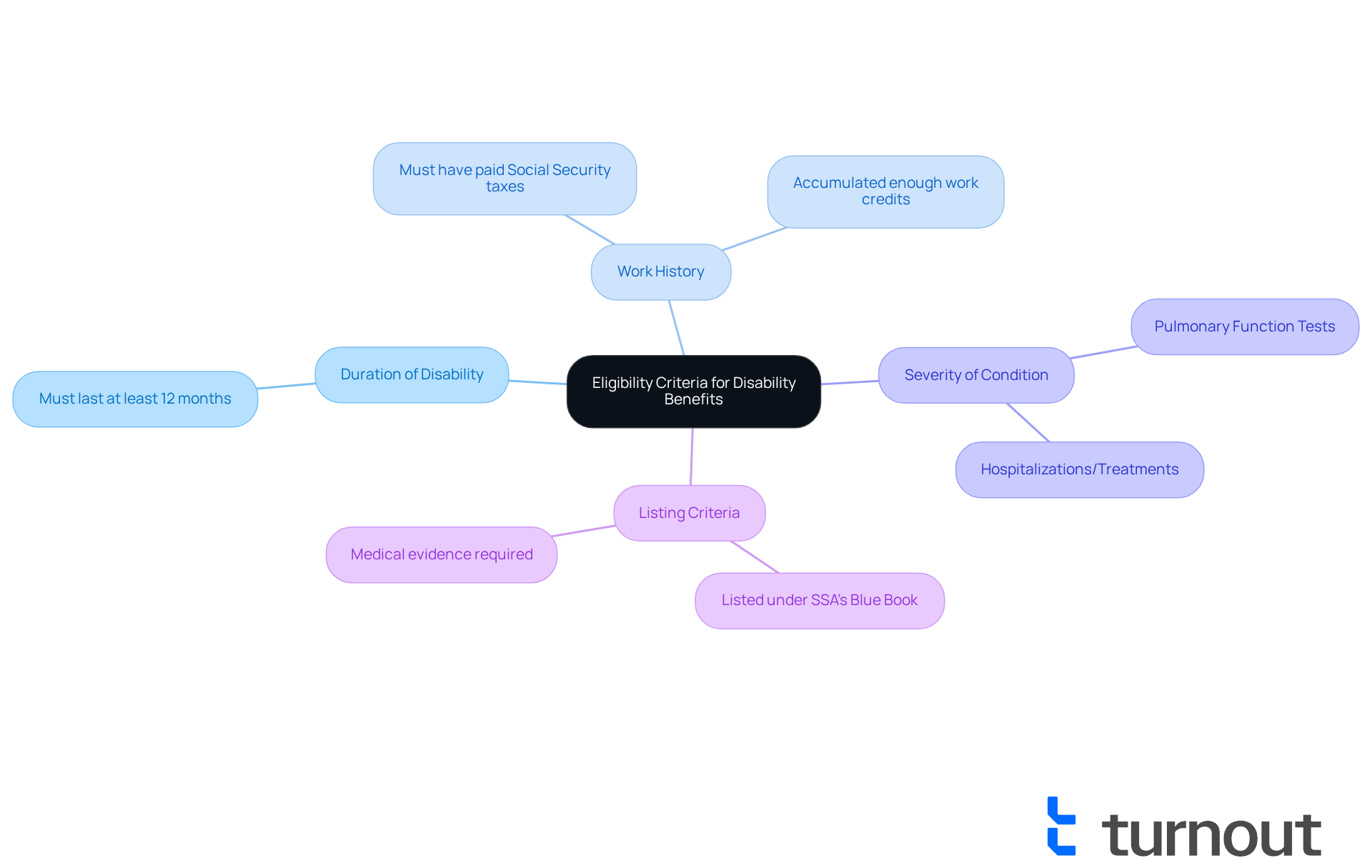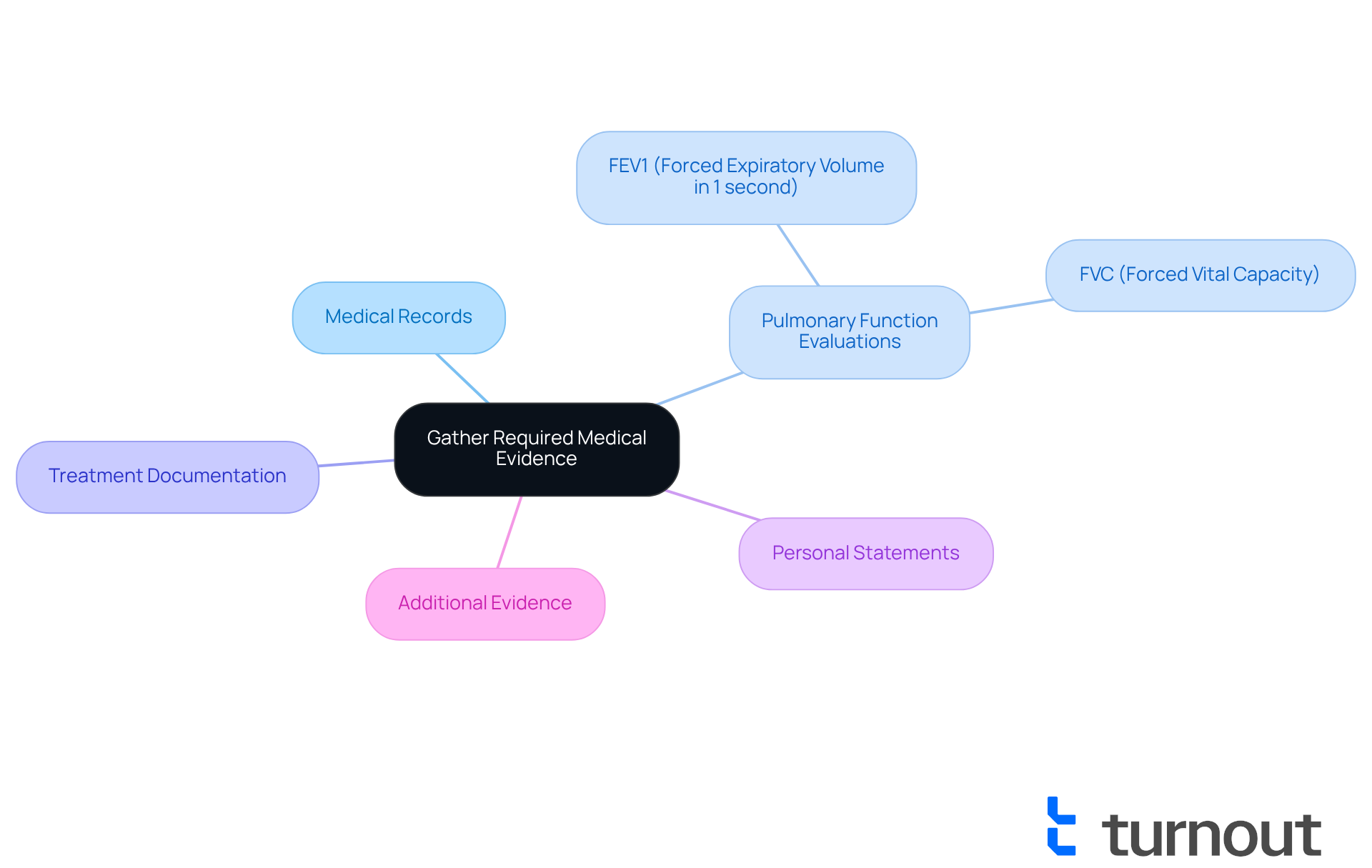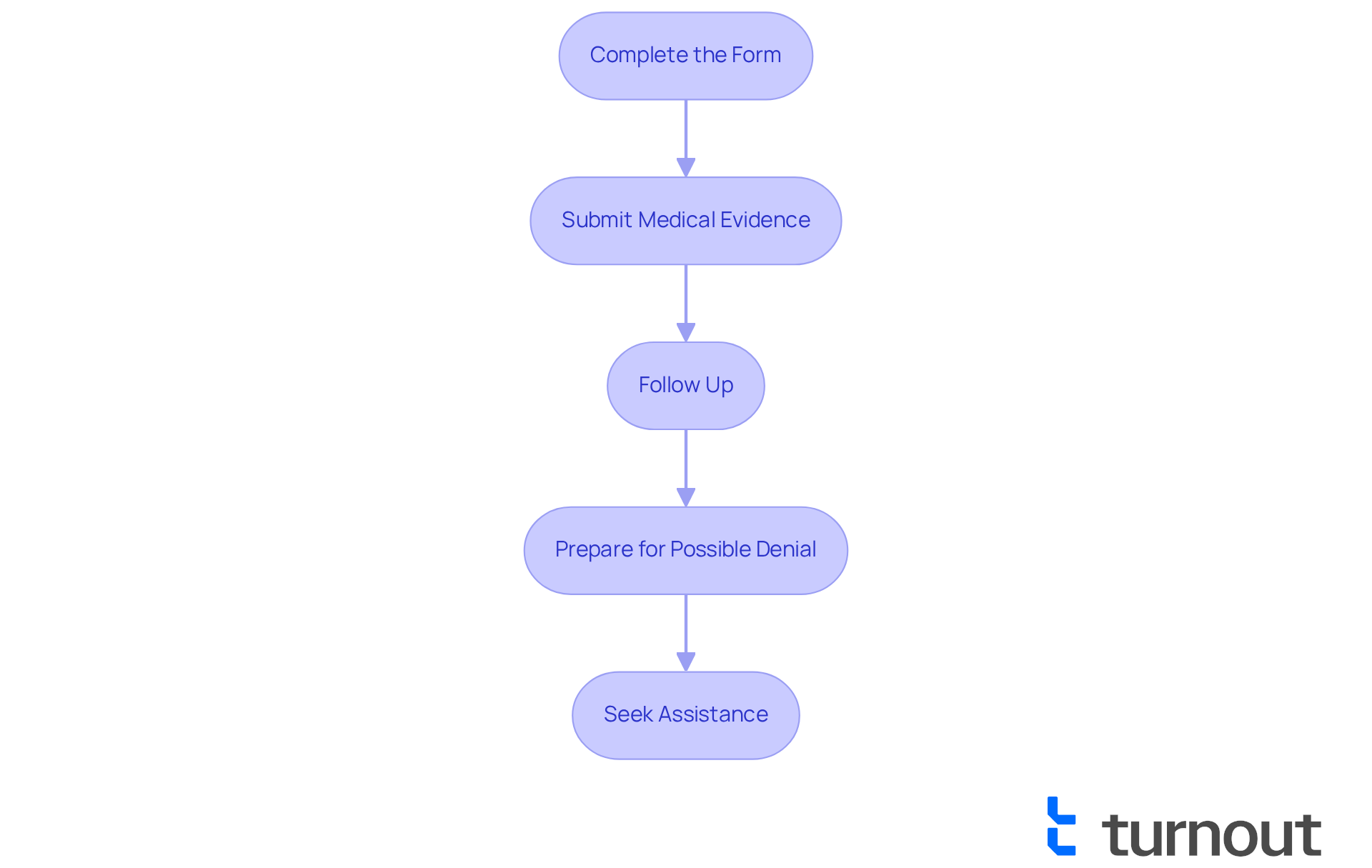Overview
Navigating the process to receive disability benefits for Chronic Obstructive Pulmonary Disease (COPD) can feel overwhelming. We understand that this journey is filled with challenges, and you may have many questions. Typically, the process requires meeting specific eligibility criteria set by the Social Security Administration (SSA), including the severity of your condition and the need for sufficient medical documentation.
To help you through this, it's essential to gather the necessary medical evidence. This step is crucial in supporting your claim. The application process can be complex, but with thorough preparation and a clear understanding of the SSA's requirements, you can increase your chances of a successful claim.
Remember, you are not alone in this journey. Many have faced similar struggles and found support along the way. We encourage you to take the time to understand what is needed, as this knowledge can empower you in your pursuit of benefits. If you have any concerns or need assistance, please reach out—we're here to help.
Introduction
Chronic Obstructive Pulmonary Disease (COPD) is a debilitating condition that affects millions, making even simple tasks feel insurmountable. We understand that for those grappling with its impact, the journey to secure disability benefits can be daunting yet essential. This guide offers a clear roadmap, detailing the steps necessary to navigate the complex application process. It also highlights the critical medical evidence required to support your claims.
But what happens when the path to obtaining these benefits is fraught with uncertainty and potential denial? It's common to feel overwhelmed. Exploring this question can illuminate the challenges faced by many and reveal strategies for overcoming them. Remember, you are not alone in this journey, and we're here to help.
Understand Chronic Obstructive Pulmonary Disease (COPD)
Chronic Obstructive Pulmonary Disease (COPD) is a progressive lung condition that includes issues like emphysema and chronic bronchitis. It's common to feel increasingly breathless, experience a chronic cough, and produce sputum. Understanding the seriousness of your respiratory condition is crucial. The Social Security Administration (SSA) requires proof of how your illness affects your ability to work.
Symptoms can vary, but common indicators include:
- Shortness of breath, especially during physical activities.
- A persistent cough that may produce mucus.
- Wheezing or a tight feeling in the chest.
Recognizing these symptoms and their impact on your daily life is the first step in understanding how long does it take to get disability for COPD. We understand that navigating the process to find out how long does it take to get disability for COPD can be overwhelming. Turnout provides valuable tools and services to assist you with your SSD claims, ensuring you receive the financial support you need without the complexities of legal representation.
Our trained nonlawyer advocates are here to support you in understanding your rights and the necessary steps to take for your SSD claims. Remember, you are not alone in this journey.

Identify Eligibility Criteria for Disability Benefits
Navigating the journey to qualify for disability benefits due to chronic obstructive pulmonary disease (COPD) can feel overwhelming, especially when considering how long does it take to get disability for COPD. We understand that you may be facing significant challenges, and it’s important to know that you’re not alone in this process. To help, let’s explore the specific criteria set by the Social Security Administration (SSA) that you must meet:
- Duration of Disability: Your COPD must have lasted, or be expected to last, at least 12 months.
- Work History: It’s essential that you have worked in jobs where you paid Social Security taxes, accumulating enough work credits to qualify.
- Severity of Condition: Your condition must significantly hinder your ability to perform basic work tasks. This is often evaluated through medical documentation, which may include:
- Results from pulmonary function tests (PFTs).
- Evidence of hospitalizations or treatments related to your COPD.
- Listing Criteria: COPD is listed under the SSA’s Blue Book, specifically under respiratory disorders. To qualify under this listing, you’ll need to provide medical evidence that demonstrates how long does it take to get disability for COPD based on the severity of your condition.
At Turnout, we’re here to assist you in navigating these criteria for Social Security Disability (SSD) claims. Our trained nonlawyer advocates offer support throughout the submission process, ensuring you receive the guidance you need without the necessity of professional representation. Remember, you don’t have to face this journey alone.

Gather Required Medical Evidence and Documentation
Gathering the right medical evidence is a crucial step in your disability application process, especially when considering how long does it take to get disability for COPD. We understand that this can feel overwhelming, but we’re here to help you through it. Here’s what you need to collect:
- Medical Records: Acquire records from your healthcare providers that outline your respiratory condition diagnosis, treatment history, and any hospital stays.
- Pulmonary Function Evaluations: These evaluations assess how effectively your respiratory system is functioning and are essential for illustrating the severity of your condition. Key metrics include:
- FEV1 (Forced Expiratory Volume in 1 second)
- FVC (Forced Vital Capacity)
- Treatment Documentation: Include records of medications prescribed, therapies undertaken, and any lifestyle changes recommended by your healthcare provider.
- Personal Statements: Consider writing a personal statement that describes how chronic obstructive pulmonary disease impacts your daily life and ability to work. This can provide context to your medical records.
- Additional Evidence: If applicable, gather evidence of any other conditions that may impact your ability to work, as these can strengthen your case.
It’s important to note that most respiratory diseases, including COPD, are progressive and can worsen over time if untreated, leading many to wonder how long does it take to get disability for COPD. Routine pulmonary function assessments are vital. Many individuals are unaware of their respiratory disease until they have experienced considerable respiratory capacity loss. Yearly testing, or more frequent assessments if necessary, is vital for monitoring disease progression and evaluating treatment effectiveness. As Dr. Sumer emphasizes, "Final results will be evaluated by healthcare professionals to ensure the best outcomes for patients."
By ensuring thorough documentation, including insights from case studies on obstructive and restrictive lung conditions, you can significantly enhance your chances of a successful disability claim. Remember, you are not alone in this journey, and taking these steps can make a meaningful difference.

Navigate the Disability Application Process
Navigating the disability application process can feel overwhelming. We understand that this journey can be filled with uncertainty and concern. However, following these steps can help simplify the process and provide you with the support you need:
- Complete the Form: Begin by filling out the SSA’s request for disability benefits. This can be done online, by phone, or in person at your local SSA office. Remember, taking this first step is crucial.
- Submit Medical Evidence: Along with your request, submit all gathered medical evidence. Ensure that all documents are clear and legible. This evidence is vital in supporting your claim.
- Follow Up: After submitting your request, keep track of its status. You can do this online or by contacting the SSA directly. Staying informed can alleviate some anxiety.
- Prepare for Possible Denial: It’s common for initial applications to be denied. If this happens, don’t be discouraged. You can appeal the decision within 60 days. Gather additional evidence if necessary to strengthen your appeal. Remember, persistence is key.
- Seek Assistance: If you find the process challenging, consider reaching out to Turnout. Our trained nonlawyer advocates specialize in assisting with SSD claims, providing guidance and support throughout the process. It’s important to note that Turnout is not a law firm and does not provide legal advice. We also work with IRS-licensed enrolled agents for tax debt relief, ensuring you have access to qualified professionals who can help you navigate these complex systems. You're not alone in this journey; we're here to help.

Conclusion
Understanding the journey to secure disability benefits for Chronic Obstructive Pulmonary Disease (COPD) is essential for those affected by this progressive lung condition. We understand that the process can seem daunting, but with the right knowledge and support, individuals can navigate the complexities of the Social Security Administration’s requirements and improve their chances of receiving the financial assistance they need.
Key elements discussed in this guide include:
- Recognizing the symptoms of COPD
- Identifying eligibility criteria for benefits
- Gathering necessary medical documentation
- Effectively navigating the application process
Each step is crucial. From understanding the specific medical evidence required to demonstrating how the illness impacts one’s ability to work, these guidelines empower applicants to present a stronger case for their disability claims.
Ultimately, the path to obtaining disability benefits for COPD may be intricate, but it is not insurmountable. With persistence, thorough documentation, and the right support, individuals can take proactive steps toward securing the assistance they deserve. Remember, empowerment through knowledge and the willingness to seek help can make a significant difference in this journey—ensuring that those living with COPD are not left to face their challenges alone.
Frequently Asked Questions
What is Chronic Obstructive Pulmonary Disease (COPD)?
Chronic Obstructive Pulmonary Disease (COPD) is a progressive lung condition that includes issues like emphysema and chronic bronchitis, leading to symptoms such as breathlessness, chronic cough, and sputum production.
What are the common symptoms of COPD?
Common symptoms of COPD include shortness of breath, especially during physical activities, a persistent cough that may produce mucus, and wheezing or a tight feeling in the chest.
Why is it important to understand the seriousness of COPD?
Understanding the seriousness of COPD is crucial because the Social Security Administration (SSA) requires proof of how the illness affects an individual's ability to work when applying for disability benefits.
How can I find out how long it takes to get disability for COPD?
Navigating the process of determining how long it takes to get disability for COPD can be overwhelming, but resources such as Turnout provide valuable tools and services to assist with SSD claims.
What support is available for those applying for SSD claims related to COPD?
Trained nonlawyer advocates from organizations like Turnout are available to support individuals in understanding their rights and the necessary steps for SSD claims, ensuring they receive the financial support they need.




